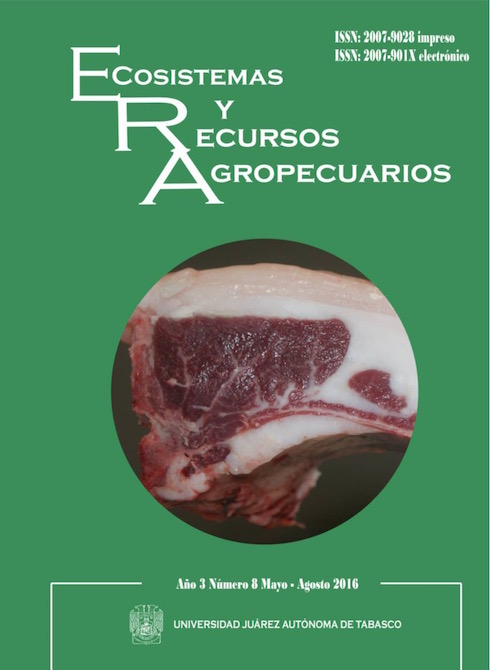MOLECULAR SURVEY OF Ehrlichia canis IN DOGS FROM MEXICO: PREVALENCE OF INFECTION AND POSSIBLE FACTORS ASSOCIATED
DOI:
https://doi.org/10.19136/era.a3n8.778Keywords:
Dogs, Ehrlichia canis, Prevalence, Nested-PCR, Yucatan-MexicoAbstract
A cross-sectional study was performed to estimate the prevalence of infection of Ehrlichia canis in dogs and to explore the factors associated with the presence of the bacteria. The study was carried out in a village in Yucatan, Mexico. Blood samples were obtained from 200 dogs. Samples were analyzed by nested-PCR to detect the presence of E. canis DNA and thrombocyte counts were calculated. One-hundred and forty of the dogs (70 %) were found to be infested with ticks. A total of 1 116 ticks were recovered and all were identi ed as Rhipicephalus sanguineus. The prevalence of E. canis infection was 69.2 %. None of the variables studied (gender, age, body condition, platelet-related bleeding, thrombocytopenia, and presence of ticks) showed association with E. canis infection. In conclusion, there is a high probability that dogs living in Yucatan, Mexico are infected with E. canis.
Downloads
References
Aguirre E, Tesouro M, Amusategui I, Rodríguez-Franco F, Sainz A (2008). Comparison between
different polymerase chain reaction methods for the diagnosis of Ehrlichia canis infection. Annals
of the New York Academic Sciences 1149:118–120.
Bulla C, Kiomi Takahira R, Pessoa Araujo J, Trinca LA, Souza Lópes R, Wiedmeyer CE (2004).
The relationship between the degree of thrombocytopenia and infection with Ehrlichia canis in an
endemic area. Veterinary Research 35:141–146.
Carvalho FS, Wenceslau AA, Carlos RS, Albuquerque GR (2008). Epidemiological and molecular
study of Ehrlichia canis in dogs in Bahia, Brazil. Genetic Molecular Research 7:657–662.
Cheesbrough M, McArtur J (1979). Manual de laboratorio para hospitales rurales en zonas
tropicales. México DF: Continental:77–78.
Dagnone AS, De Morais HS, Vidotto MC, Jojima Vidotto O (2003). Ehrlichiosis in anemic,
thrombocytopenic, or tick-infested dogs from a hospital population in South Brazil. Veterinary
Parasitology 117:85–290.
Dantas-Torres, F (2010). Biology and ecology of the brown dog tick, Rhipicephalus sanguineus.
Parasites & Vectors 3:1–26.
De Blas N, Ortega C, Frankena K, Noordhuizen J, Thrusfield M (2000).. WinEpiscope 2.O
Universidades de Zaragoza (España), Wageningen (Holanda) y Edimburgo (Escocia).
Harrus S, Wane, T, Avidar Y, Bogin E, Peh H, Bark H (1996). Serum protein alterations in canine
ehrlichiosis. Veterinary Parasitology 66:241–249.
Harrus S, Bark H, Waner T (1997). Canine monocytic ehrlichiosis: an update. Compendium Continuing Education Practicing Veterinarian 19:431–444.
Instituto Nacional de Estadística, Geografía e informática (INEGI) (2002). Anuario estadístico del
Estado de Yucatán, México. Instituto Nacional de Estadística, Geografía e informática, Mexico.
Inokuma H, Oyamada M, Davoust B, El Boni M, Dereure J, Bucheton B, Hammad A, Watanabe
M, Itamoto K (2006). Epidemiological survey of Ehrlichia canis and related species infection in
dogs in Eastern Sudan. Annals of the New York Academic Sciences 1071:461–463.
Jiménez-Coello M, Pérez-Osorio C, Vado-Solis I, Rodríguez-Buenfil JC, Ortega-Pacheco A
(2009). Serological survey of Ehrlichia canis in stray dogs from Yucatan, Mexico, using two
different diagnostic tests. Vector-Borne Zoonotic Disease 9:209–211.
Downloads
Published
Issue
Section
License
Aviso de copyright
Los autores que se envían a esta revista aceptan los siguientes términos:
una. Los autores conservan los derechos de autor y garantizan a la revista el derecho a ser la primera publicación del trabajo con una licencia de atribución de Creative Commons que permite a otros compartir el trabajo con un reconocimiento de la autoría del trabajo y la publicación inicial en esta revista.
B. Los autores pueden establecer acuerdos complementarios separados para la distribución no exclusiva de la versión del trabajo publicado en la revista (por ejemplo, en un repositorio institucional o publicarlo en un libro), con un reconocimiento de su publicación inicial en esta revista.
C. Se permite y se anima a los autores a difundir su trabajo electrónicamente (por ejemplo, en repositorios institucionales o en su propio sitio web) antes y durante el proceso de envío, ya que puede conducir a intercambios productivos, así como a una cita más temprana y más extensa del trabajo publicado. (Consulte El efecto del acceso abierto).

